The suffragette campaign spearheaded by Mrs Pankhurst’s Women’s Social and Political Union (WSPU) was a time of heady excitement, courage, endurance and persistence. Women marched under stirring banners – From Prison to Citizenship, Deeds Not Words, Ask With Courage (a pun on prime minister Asquith's name). They endured violence and imprisonment in their quest for justice. They made news – and for some they also made money.
The
Keeloma Dairy Company was one of the businesses which saw the suffragette campaign
as a marketing opportunity. In 1907 they advertised their “butter substitute”
in the Yorkshire Evening Post with a
stock cartoon image of the suffragette – ugly, mannish and strident. The
advertisement reads:-
The suffragette says she ought to have a
vote. Maybe it would be policy, perhaps not. But what we do know is that when
once ladies have tried Keeloma, they unanimously vote it of a delicious creamy
flavour, and quite equal to freshly-churned country butter.
The Keeloma
advertisement appeared, whether by accident or design, on the same page as a
report of a suffragette deputation to the House of Commons on 20 March 1907.
Other
companies didn’t just use the suffragette campaign to advertise their wares,
they developed products aimed at the campaigners. The Kensington store Derry
& Toms carried a range of hats in the colours of various organisations due
to take part in a demonstration on 17 June 1911. It was, they said, “a unique
opportunity for purchasing suitable millinery for the great Procession”. On Oxford Street,
Selfridges sold blouses, ribbons, badges and “dainty wrist bags” in the WSPU colours –
purple, white and green. William Owen sold white
dresses for wearing in suffrage processions.
Swan
and Edgar, Burberrys and Peter Robinsons were amongst other stores which
offered clothes and accessories for suffragettes, as well as for non-militant
campaigners of the National Union of Women’s Suffrage Societies. The NUWSS colours
were green, white and red. Unfortunately for these stores, their willingness to
commercialise the suffrage movement didn’t protect their windows when the WSPU
launched its window-smashing campaign.
The suffragette
campaign inspired money makers from swanky department stores to “gutter merchants”.
The London Daily News reported on 22
March 1907 that hawkers outside the police courts, where 75 women and one man
were being tried after the violent demonstration outside the House of Commons
on 20 March, were doing a “roaring trade” selling postcards of suffragette leaders.
Alongside
the postcard sellers was one vendor who demonstrated the true entrepreneurial
spirit. Pitched as “Spoils of the Fight”, he sold items harvested from the
women’s struggle to breach the police cordons around the House of Commons. His
goods included torn pieces of clothing, hatpins, feathers, and hair – souvenirs
of the brutal opposition women met with when they demanded the vote.
You
can find out more about suffragette merchandise, including goods sold by
the WSPU themselves (tea, soap, badges etc), in Diane Atkinson’s book The Purple White & Green: London 1906-14
(London: Museum of London, 1992).
See
also Theatre and Fashion: Oscar Wilde to
the Suffragettes, Joel H Kaplan and Sheila Stowell (Cambridge: Cambridge
University Press, 1994).


Comments
Post a Comment